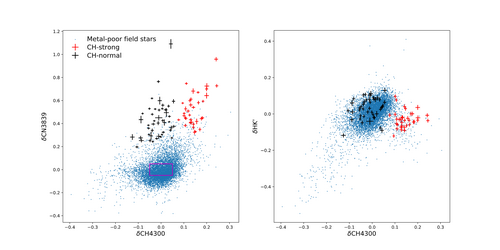
As a bar-spiral galaxy, our Milky Way (MW) is quite active chemically and dynamically. Among our MW stars, is it possible to know the evolution of each star, in order to accurately study the MW formation and evolution? Recently, scientists from chemodynamics have been trying to understand the stellar and MW evolution history using both chemical and dynamic information.
Nitrogen-rich field stars are a group of very interesting stars: we usually find high nitrogen (N) abundances in globular cluster (GC) stars, but now this kind of stars are also found in the field. Do they come from GCs, or from other sources? This may change our understanding about the mutual inter action between MW and star clusters.
Recently, TANG Baitian from Sun Yat-sen University, LIU Chao from National Astronomical Observatories of Chinese Academy of Sciences (NAOC), and their collaborators found 44 N-rich metal-poor field red giants from LAMOST DR3. These stars are rare by their nature (<1% of the parent sample), and their origin is still unknown. Their findings were published in Astrophysical Journal.
The N-enhancement of these stars was confirmed using their derived N abundances from both APOGEE and LAMOST spectra. It was clear that this group of stars had higher N abundances compared to other normal metal-poor field red giants, indicating special nucleosynthesis was required to explain their origins. Then, TANG and his collaborators combined 3D positions and 3D velocities of these stars with the MW gravitational models to simulate their orbits.
The results from Monte-Carlo simulation indicated that these stars had high eccentricity, and some of them were count-rotating in our MW. According to their chemical and kinematic information, they speculated that these stars may come from MW GCs, dwarf galaxies, or extragalactic GCs. More data is needed before drawing firm conclusion.
In the near future, the researchers will continue to explore N-rich stars by using the newer version of LAMOST data to expand the sample size. At the same time, high-res spectra from large telescopes will tell us better stories about N-rich star origins with more chemical abundances and radial velocities at different epochs.

After measuring CN and CH spectral indices from the LAMOST spectra, researchers identified 44 CN-strong CH-normal stars (N-rich stars, black pluses), and 35 CN-strong CH-strong stars (CH stars, red pluses). Background stars are normal metal-poor field red giants. (Image by NAOC)

86-10-68597521 (day)
86-10-68597289 (night)

86-10-68511095 (day)
86-10-68512458 (night)

cas_en@cas.cn

52 Sanlihe Rd., Xicheng District,
Beijing, China (100864)

